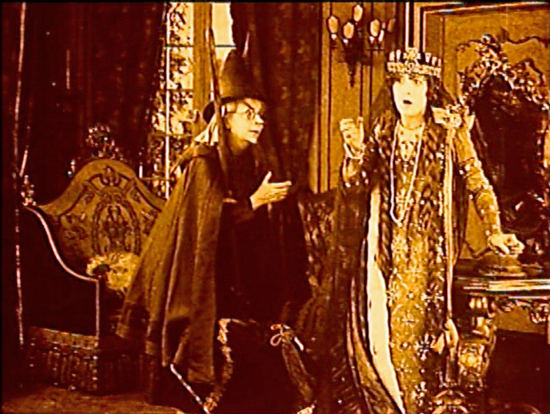Run Time: 63 minutes. Studio: Famous Players/Paramount. Director: J. Searle Dawley. Writer: Winthrop Ames. Based on a play by Winthrop Ames. and a book by The Brothers Grimm. Producer: H. Lyman Broening. Main Cast: Marguerite Clark, Dorothy G. Cumming, Creighton Hale, Lionel Braham, Alice Washburn. Cinematographer: H. Lyman Broening.
Anyone who reads my blogs knows that I am a huge Disney fan. Because of this often times when a classic fairy tale is brought up it is the Disney version that first comes to my mind. However these stories existed long before Walt touched them and they even had film adaptions before then. Some of these film adaptions even were huge influences on the Disney movies. One of the most clear example of this is the 1916 silent version of Snow White. Now some of my fellow Disney buffs may have heard of this movie. Walt Disney had in fact seen it as a teenager and legend goes that it inspired him to make his own film version of the classic fairy tale. Still this movie has more than that great story behind it. It is also a delightful film in its own right.
Though this film was obviously inspired by the Brothers Grimm's classic story, it had an even more direct and recent piece of source material. This was a 1912 play based off of the story. That play was written by Winthrop Ames, and starred Marguerite Clark, who also were the writer and star of this film adaption. So in many ways the point of this movie was simply to bring that stage play to the screen. Considering the differences between the stage and the silent cinema there naturally needed to be some changes made. The most obvious of these was to eliminate song numbers and very dialogue heavy scenes. However interestingly more scenes were added starring the Huntsman. These scenes revolved around him being locked in the tower as a prisoner. Also in adapting it for film, director J. Searle Dawley employed some more cinematic techniques. For instance in this version of the story the Witch (a separate character from the Queen) wants Snow White's heart to help with a potion to get herself her. When she is given a pig's heart instead her head grows pig's tails instead of hair. On stage the actress simply ducked off stage real quick and put on a head cap. Here the pig's tails appear to slowly fade in on her head, accomplished by a dissolve shot (Searle Dawley later remembered doing this on a set with crowded extras in 1916 made this a very difficult technical challenge).
The film interestingly begins with a brief prologue involving Santa Claus leaving a bunch of dolls at a little girl's house. These dolls become real people and then our story really begins. A Queen wants a beautiful child and gets one in Snow White (played by Marguerite Clark). However when this Queen passes away, the king remarries. The new Queen (played by Dorothy Cummings) is an evil and jealous woman who hates Snow White. When the King dies there is no one to protect Snow White from this evil woman. Snow White now has to work in rags as a maid, but this isn't all that is planned for her. The jealous Queen conspires with a witch (played by Alice Washburn) to get rid of Snow White. In return for helping the Queen, the Witch wants Snow White's heart. The Queen hires the huntsman (played by Lionel Braham) to take care of Snow White. However the huntsman can't do it and gives the queen the heart of a pig instead. Snow White hides out at a house of dwarfs, who promise to help her, however they can. The Queen learning that the huntsman has failed her, decides to kill Snow White herself.
What really makes this film work is Marguerite Clark's performance as Snow White. In this era of such stars as Mary Pickford and Lillian Gish, it was common for grown women to play the part of little girls. Though Clark turned 33, the year this film was released, she plays the part so well you completely believe she is about 10 or 12. There is just a great sense of innocence to this performance. This is best shown in the scene with the huntsman. She clings to the huntsman and is simply so excited to be with him. She acts like the two are going to play games with each other. When the huntsman says what they are really out there for she easily assumes that he is joking. In a lesser actress' hands this could have felt very forced but here it comes out naturally. Later when she goes into the dwarfs cottage she not wanting to impose knows that if she only takes small bites from each plate, they can't possibly be mad at her. Clark does that so delicately that it gives that small moment extra charm to it.
However if there is something this film is lacking in, it is a real sense of danger. While the Disney film wasn't intended just for kids (in fact in Britain, it got an adults only rating because of how scary the witch is), the play this movie was based on and even to a certain extant this movie itself was aimed primarily at children. Because of this the villains don't feel as threating as the Queen in the Disney version (being aimed mostly at adults) could. While this silent film is quite good, this does result in the Disney movie being even better.
While Walt Disney's film is easily the superior version, this little movie has such a sweet and simple charm to it will still delight today's modern audiences.
Resources Used
http://www.jbkaufman.com/movie-of-the-month/snow-white-1916
The Animated Man: A Life of Walt Disney by Michael Barrier

No comments:
Post a Comment